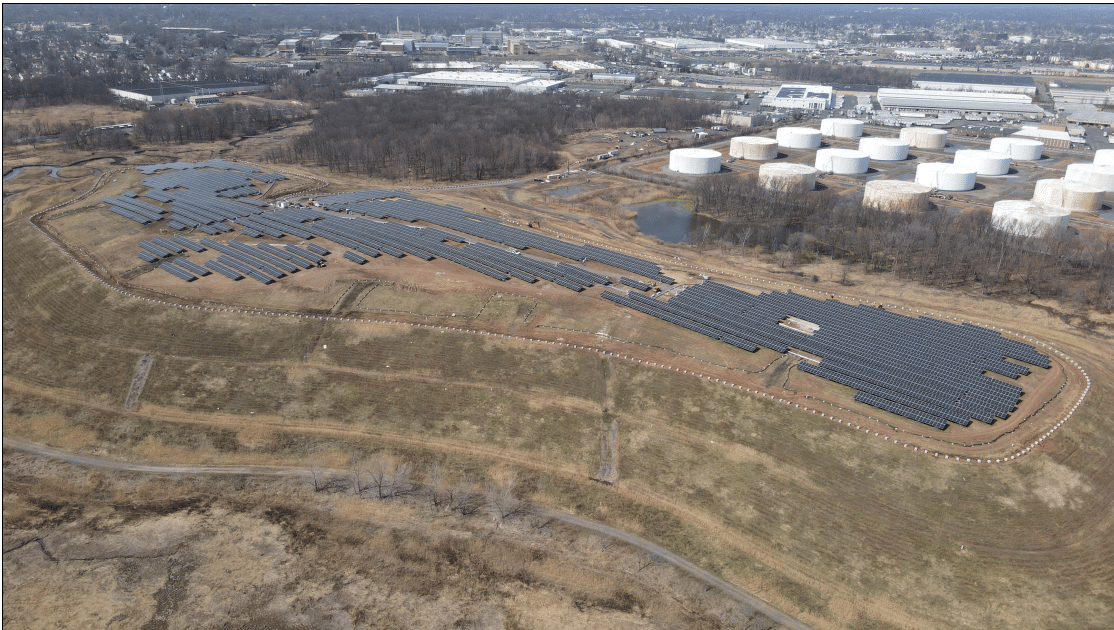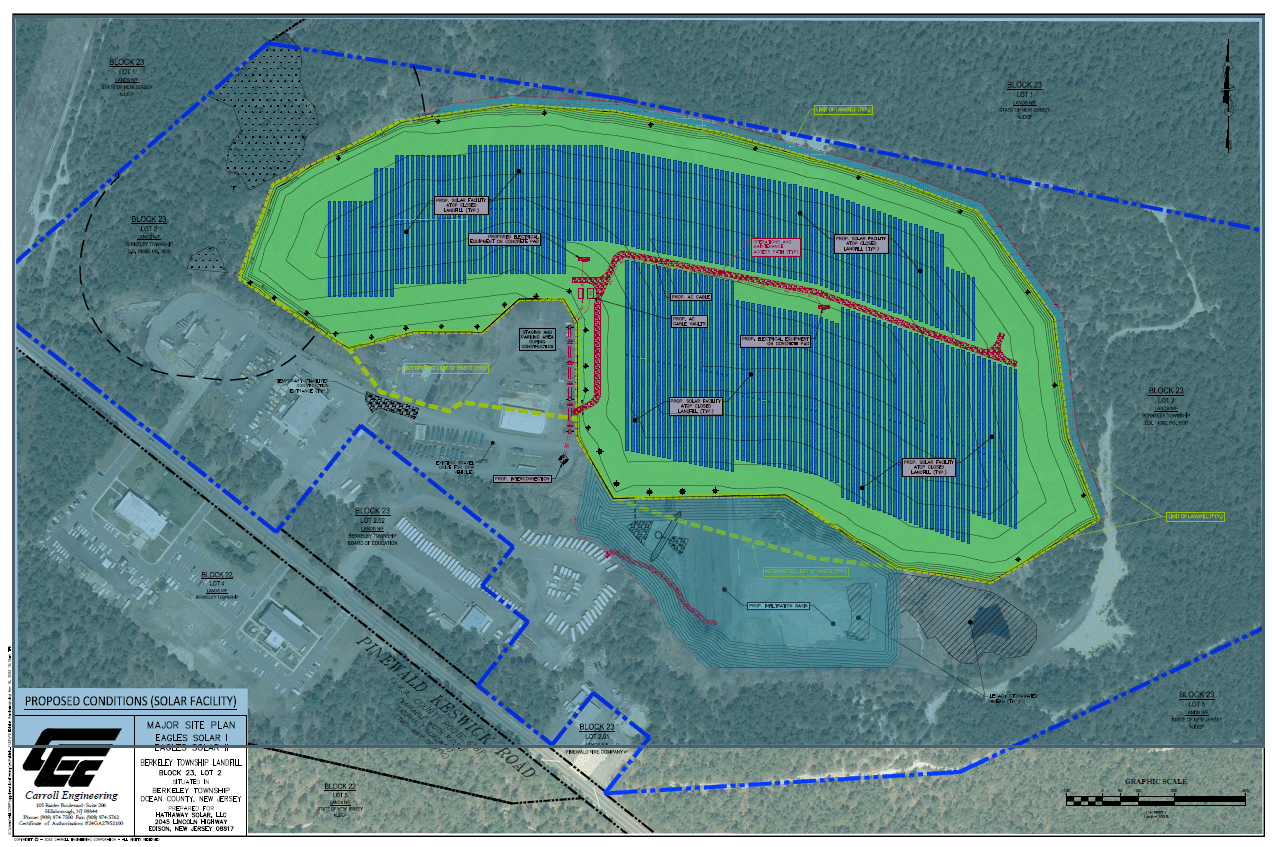

Solar farms are becoming an increasingly popular way to generate clean, renewable energy. A solar farm is a large-scale facility that uses solar panels to convert the energy from the sun into electricity. Solar panels are also known as photovoltaic (PV) panels, and they provide esidential homeowners, commercial and industrial businesses, and public entities access to cost-effective, renewable energy.
Solar farms vary in size, with some being as small as a few acres and others being as large as several hundred acres! These “farms” are typically located in areas that receive a lot of sunlight, such as open rural areas or closed landfills , but they can also be found on rooftops in urban areas.
In this blog, we’ll explore the potential of deploying solar farms on closed landfills as an initiative to produce green energy that fosters environmental sustainability.
First, how do solar panels work?

Pictured here is a diagram detailing how solar panels work. Image credit: AGL Solar Energy via Wikimedia Commons
Solar panels are made up of semiconductor materials that absorb sunlight and convert it into direct current (DC) electricity. This DC electricity is then sent through an inverter which converts it into alternating current (AC) electricity. This AC electricity is then fed into the power grid to be distributed to homes and businesses.
Types of Solar Farms

Here’s an example of a ground-mounted solar panel located in rural solar farm.
Solar panels are generally installed on the ground, known as ground-mounted, and on roofs, known as rooftop.
Ground-mounted solar farms are typically found in large, open spaces, where the solar panels are mounted on structures that elevate them above the ground. A ground-mounted solar farm is usually found in large, open spaces where tree shading does not cast on panels. The panels are mounted on a racking system that elevates them above the ground. The ground below the panels is usually covered with grass.
Rooftop solar farms are typically found on the rooftops of commercial or industrial buildings and are integrated into the structure of the building. A rooftop solar system is typically found on top of roofs of residential, commercial, and industrial buildings. Some large buildings have panels covering the entire roof of the building

The image above displays rooftop solar panels; rooftop panels are commonly used in urban areas, on homes, and in locations where sunlight is best sourced through the roof of a structure.
One of the greatest advantages that solar farms offer is their ability to generate clean, renewable energy. They do not produce any emissions or pollutants, and they do not deplete natural resources like fossil fuels. Additionally, they can help reduce dependence on non-renewable energy sources and decrease the overall carbon footprint.
How are closed landfills relevant to solar farms?
In the United States, when a landfill is “closed,” landfill waste is typically covered with a geomembrane and/or a layer of soil and vegetation. This process is called capping, which isolates contaminants and waste and keeps them in place to avoid the emission of odors and the spread of contamination and pollutants.
Once a landfill is capped, the land cannot be used for any development, such as building homes or other structures. The land often remains vacant and unused. However, municipalities and utility companies have begun to create solar farms landfills to make use of this – otherwise unusable – space.
What are the benefits of transforming capped landfills into solar farms?
There are many benefits to converting cl landfills into solar farms, including:
- Utilization of vacant land: Solar farms provide a way to put unused land to productive use. They can generate electricity, provide jobs, and generate revenue for the local government or businesses.
- Environmental benefits: Solar farms generate clean, renewable energy and do not produce any emissions or pollutants. They can help reduce dependence on non-renewable energy sources and decrease the overall carbon footprint.
- Cost-savings: Building a solar farm on a closed landfill can be more cost-effective compared to building a solar farm on a new piece of land. Solar panels can be placed on sloping landfills and have easy access to existing infrastructure, such as roads and power lines, which can reduce the cost of constructing solar farms.
- Meeting Renewable Energy Goals: Many municipalities and businesses have determined specific goals for operating on clean, renewable energy. Solar farms can help municipalities and businesses to achieve these energy goals.
- Combining environmental benefits: In addition to generating renewable energy, using a closed landfill for a solar farm can also help to prevent the release of harmful pollutants, reduce odors, and provide a more visually appealing landscape.
Creating solar farms on closed landfills is a win-win solution that provides environmental, economic, and societal benefits. It’s a great example of how sustainable development can be achieved by tackling multiple challenges with complimentary solutions to create a mutually beneficial outcome.
What are some “real-life” examples of landfills or unused land that have been transformed into solar farms?
In recent years, closed landfills have been converted into solar farms in our local areas, including Pennsylvania, New Jersey, and Delaware.
Examples include the Tioga Landfill in Philadelphia, which generates 4.4 megawatts of electricity and provides power to over 800 homes; the Trenton Solar Farm in New Jersey, which generates 4.4 megawatts of electricity and provides power to over 800 homes; and the Cherry Island Landfill in Wilmington, Delaware which generates 3 megawatts of electricity and provides power to over 500 homes.
Additionally, our own civil engineering firm, Carroll Engineering Corporation, has contributed to large-scale solar projects in the tri-state area! In collaboration with CS Energy, LLC in Edison, NJ, we obtained site plan approval for the Linden Hawk Rise Solar project in the City of Linden. Built on the City’s former landfill, the community solar farm project generates 4.5 MW of clean energy to approximately 800 residents, most of which are low to moderate income.

Carroll Engineering Firm partners with CS Energy, LLC to create New Jersey’s largest solar farm to date. The solar project is part of the U.S. Navy’s energy resilience initiative.
Another project Carroll Engineering contributed to recently was the Eagles Solar I and II solar facility at the Berkeley Township Landfill in Ocean County, NJ. Our team performed boundary and topographic surveys, as well as major site plans, for the solar project. This project was particularly challenging, as our designs needed to accommodate requirements by the Pinelands Commission and NJDEP. The closing of the landfill and subsequent construction of the 10-MW facility atop the closed landfill is underway.

Carroll Engineering is excited to be at the forefront of implementing new methods and technologies in the renewable energy industry. As businesses and municipalities across the U.S. continue to seek ways to generate clean energy, it’s likely that solar farms will become more of a “mainstream” concept recognized by the public.
In conclusion…
Solar farms are becoming a popular way to generate electricity as the technology and cost of solar panels continue to improve, making them more competitive with traditional energy sources. Solar farms provide a reliable source of clean, renewable energy. They are playing a key role in the United States’ efforts to transition toward renewable energy sources and reach climate change targets. These efforts also welcome economic benefits such as employment opportunities and revenue generation, in addition to improving energy security by reducing dependence on fossil fuels.
How Can Carroll Engineering Help Your Next Project?
Carroll Engineering Corporation is a professional Civil Engineering firm that services the Tri-State area, with proven experience on large-scale solar and renewable energy projects. We also deliver highly regarded professional services including surveying, planning & site design, water facilities engineering, wastewater engineering, traffic & transportation engineering, municipal engineering and beyond to a wide range of municipal, public and private clients.
We have offices located in Warrington, PA (Bucks County), King of Prussia, PA (Montgomery County), Malvern, PA (Chester County), and Hillsborough, NJ (Somerset County). All our departments and locations work together acting as valuable resources to each other. Our services are available to both the public and private sector. We protect the interest of our clients and believe prevention is the best way to solve problems! We’re focused on identifying and eliminating potential problems and always take an innovative design approach.
Looking for a professional engineer to help with your renewable energy project? If so, please contact Tom Fik, P.E., CEEC at 267-688-8241 or tfik@carrollengineering.com We’d love to explore your ideas and ways we can make your visions a reality!
